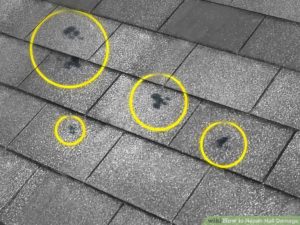Fewer Hailstorms But Bigger Hail Predicted
In a CNN article written by Judson Jones in June of 2017, he reported that although climate change caused by humans would bring fewer hailstorms in the coming years, the hail stones would likely be much bigger and more destructive. So, climate change means Fewer Hailstorms But Bigger Hail.

More specifically the article stated that a new study says that climate change is likely to reduce the number of hailstorms across North America in the coming years, but don’t get rid of your insurance policy. You will probably still need a new roof due to hail damage, as the research suggests the storms that do come will be more destructive and damaging. Fewer Hailstorms But Bigger Hail Predicted.
According to a study, published in June of 2017 in the journal called Nature Climate Change, human-induced climate change is likely to decrease the number of hailstorms while increasing the size of hail in the storms that do form. The report is quoted as saying,
“As the planet warms, we are finding that we’re having fewer rainfall events, but when it does rain, it tends to be heavier. And that seems to be what — at least what our work is suggesting — it could be what’s happening with the hail as well,” said Julian Brimelow, a researcher with Environment and Climate Change Canada, a government department, and a co-author of the study.
The research team used computer modeling simulations of hail growth to discover how hailstone growth will change in the next few years. The research team ran models for the years 1971-2000 and 2041-2070 and then compared the data. “This is not a calculation you could do on the back of an envelope,” Brimelow said. It took about six months to run the calculations for a 50-kilometer resolution model that includes most of North America, run for four time periods a day for the 30-year intervals, past and future.
“At the end of the day, we generated about a billion profiles,” he said.
Though the researchers weren’t surprised there would be less hail in the future, they were surprised it would be more damaging, he said.
According to the study, “Drier and cooler regions are predicted to experience the largest increase in hail threat,” such as the Northern Plains, whereas warm and moist areas like the Southeast are likely to see a decreased threat.
The greatest impact was found to be areas already hail-prone, like the High Plains, increasing both hail frequency and size over spring and summer.
In the past several years, billion-dollar hail events have been on the rise. There have been at least three billion-dollar hailstorms in the last two years, including one in just the past few months.
On May 8, one hailstorm in Denver, Colorado caused an estimated $1.4 billion in damage, mostly to vehicles stuck in traffic.
One could therefore expect that the amount of property damage will increase along with hail disasters.
But this all depends on where the hail falls, said Julie Rochman, president and chief executive officer of the Insurance Institute for Business & Home Safety. A hailstorm in an empty field won’t cost anyone anything, but one in a city definitely will.
The institute is also doing its own hail research focused on what causes different types and sizes of hail, as well as hailstone softness and materials that can better withstand hail damage.
The new study will help add to the understanding of the types of environments that create different “flavors” of hailstorms, Rochman said. Fewer Hailstorms But Bigger Hail Predicted.
“It’s an exciting time for hail research,” Rochman said. “A lot of bright minds are looking into how hail will change in the future.” Fewer Hailstorms But Bigger Hail Predicted.
The institute’s meteorologists were enthused by the new study, she said. In the world of climate change, she said, hail hasn’t gotten a lot of attention.
Brimelow agrees that “virtually nothing” has been done in this space.
More research is being done in Europe, where hail impacts more people due to greater population density. In North America, hail research has mostly given way to the study of tornadoes since the 1980s.
Brimelow says the researchers will be happy to share their code with anyone who wants to run it for other parts of the world.
“We are just hoping this study spurs some interest,” he said.
When you see or even suspect your roof is damaged by hail, call a roofing professional right away. The worst thing you can do is delay and wait days to contact help for your home’s roof. Hail Roof damage is not always obvious or visible from the ground. Certainly if your roof is leaking or you see missing tiles, shingles, slate or panels, an inspection is needed now. The best way to know for sure if your roof is damaged is to have a professional roofing technician carefully and thoroughly inspect your roof to detect hail storm damage and schedule a roofing repair so that additional damage does not occur to your home. Many insurance companies would love nothing more than to deny your home insurance claim due to your failure to mitigate damages. By you delaying to get the home’s roof inspected and repaired can be cause for an insurance denial. Fewer Hailstorms But Bigger Hail Predicted.
Many times, an insurance company will offer you less than your hail damage claim is worth. We have experience dealing with insurance companies. If you need help to get the full value of your hail claim, please contact us today!




